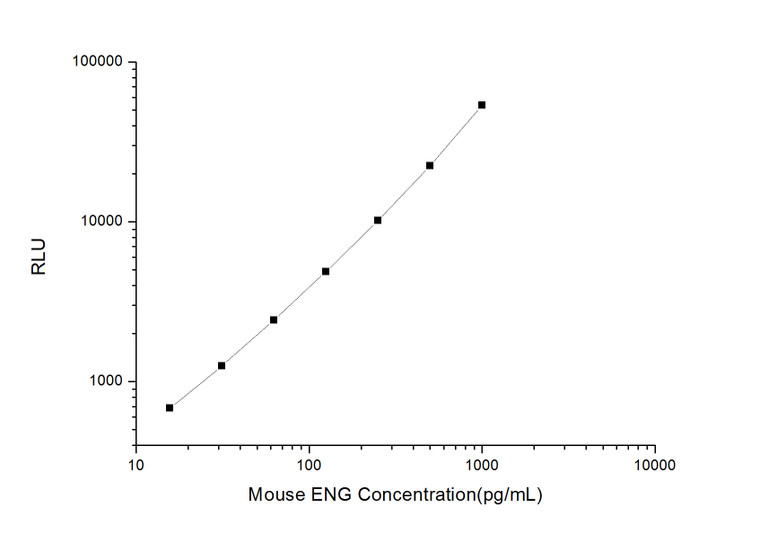| Applications: |
CLIA |
| Reactivity: |
Mouse |
| Note: |
FOR SCIENTIFIC EDUCATIONAL RESEARCH USE ONLY (RUO). MUST NOT BE USED IN DIAGNOSTIC OR OTHER MEDICAL APPLICATIONS. |
| Sensitivity: |
9.38pg/mL |
| Detection Limit: |
15.63~1000pg/mL |
| Short Description: |
This mouse ENG kit is a highly sensitive in-vitro chemiluminescent immunoassay for the measurement of trace amounts of analytes. |
| Storage Instruction: |
If unopened the kit may be stored at 2-8°C for up to 1 month. If the kit will not be used within 1 month, store the components separately, according to the component table in the manual. |
| Assay Time: |
3.5h |
| Detection: |
Chemiluminescence |
| Gene Symbol: |
Eng |
| Gene ID: |
13805 |
| Uniprot ID: |
EGLN_MOUSE |
| Specificity: |
This kit recognizes Mouse ENG in samples. No significant cross-reactivity or interference between Mouse ENG and analogues was observed. |
| Sample Type: |
Serum, plasma and other biological fluids |
| Tissue Specificity | Detected on blood vessels (at protein level). Detected on adult pulmonary artery, capillaries supporting the heart muscle and lung alveolar capillary endothelial cells. Endoglin is restricted to endothelial cells in all tissues except bone marrow and is also found in stromal cells within the connective tissue of intestine, stomach, heart, skeletal muscle, uterus, ovary, oviduct, testis and thymus. |
| Function | Vascular endothelium glycoprotein that plays an important role in the regulation of angiogenesis. Required for normal structure and integrity of adult vasculature. Regulates the migration of vascular endothelial cells. Required for normal extraembryonic angiogenesis and for embryonic heart development. May regulate endothelial cell shape changes in response to blood flow, which drive vascular remodeling and establishment of normal vascular morphology during angiogenesis. May play a role in the binding of endothelial cells to integrins. Acts as TGF-beta coreceptor and is involved in the TGF-beta/BMP signaling cascade that ultimately leads to the activation of SMAD transcription factors. Required for GDF2/BMP9 signaling through SMAD1 in endothelial cells and modulates TGFB1 signaling through SMAD3. |
| Protein Name | EndoglinCell Surface Mj7/18 AntigenCd Antigen Cd105 |
| Cellular Localisation | Cell MembraneSingle-Pass Type I Membrane Protein |
| Alternative CLIA Names | Endoglin CLIA kitCell Surface Mj7/18 Antigen CLIA kitCd Antigen Cd105 CLIA kitEng CLIA kitEdg CLIA kit |
| Specificity | This kit recognizes Mouse ENG in samples. No significant cross-reactivity or interference between Mouse ENG and analogues was observed. |
| Reproducibility | Both intra-CV and inter-CV are |
Information sourced from Uniprot.org
| Item | Specifications | Storage |
| Micro CLIA Plate (Dismountable) | 96T: 8 wells ×12 strips strips | -20℃, 6 months |
| Reference Standard | 96T: 2 vials 48T: 1 vial | -20℃, 6 months |
| Concentrated Biotinylated Detection Ab (100×) | 96T: 1 vial, 120 μL 60 μL | -20℃, 6 months |
| Concentrated HRP Conjugate (100×) | 96T: 1 vial, 120 μL 60 μL | -20℃ (Protect from light), 6 months |
| Reference Standard & Sample Diluent | 1 vial, 20 mL | 2-8°C, 6 months |
| Biotinylated Detection Ab Diluent | 1 vial, 14 mL | 2-8°C, 6 months |
| HRP Conjugate Diluent | 1 vial, 14 mL | 2-8°C, 6 months |
| Concentrated Wash Buffer (25×) | 1 vial, 30 mL | 2-8°C, 6 months |
| Substrate Reagent A | 1 vial, 5 mL | 2-8℃ (Protect from light) |
| Substrate Reagent B | 1 vial, 5 mL | 2-8℃ (Protect from light) |
| Plate Sealer | 5 pieces | |
| Manual | 1 copy | |
| Certificate of Analysis | 1 copy | |
| Sample Type | Range (%) | Average Recovery (%) |
| Serum(n=8) | 91-104 | 98 |
| EDTA plasma(n=8) | 97-111 | 103 |
| Cell culture media(n=8) | 86-100 | 92 |
| | Intra-assay Precision | Intra-assay Precision | Intra-assay Precision | Inter-assay Precision | Inter-assay Precision | Inter-assay Precision |
| Sample | 1.00 | 2.00 | 3.00 | 1.00 | 2.00 | 3.00 |
| n | 20.00 | 20.00 | 20.00 | 20.00 | 20.00 | 20.00 |
| Mean (pg/mL) | 46.16 | 110.62 | 373.66 | 46.71 | 117.42 | 340.95 |
| Standard deviation | 5.78 | 9.41 | 25.00 | 5.04 | 8.99 | 34.78 |
| CV (%) | 12.52 | 8.51 | 6.69 | 10.79 | 7.66 | 10.20 |
12 months for antibodies. 6 months for ELISA Kits. Please see website T&Cs for further guidance






